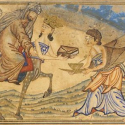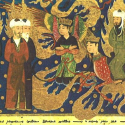Depicting Muhammad
The people’s of the Civilized World have been repeated told, most often stridently, by Muslims and their dhimmi sympathizers and supporters that any and all representational or figurative depictions of the Muslims’ prophet, Muhammad are and have always been disallowed by Islam and considered highly offensive. This is, of course and unsurprisingly, quite far from the truth.
It was quite common among wealthy Muslims during the Middle Ages to have illustrated copies of the Qur’an and hadith that had within their pages pictures of Muhammad. It was especially common during the early 14th century Ilkhanid dynasty in Persia but continued to be commonplace during Persia’s Timurid dynasty of the 14th – 18th centuries, and the Ottoman Empire had many artistic depictions throughout the 14th – 16th centuries.
Between the Timurids’ Gurkani Alam and the Ottomans’ Devlet-i Aliye-yi Osmaniyye the two empires ruled essentially the whole of the Muslim World until the mid-18th century when Western powers entered and conquered Asia Minor. That perforce means that depictions of Muhammad were not always forbidden (haram) under Shari’a.
Such illustrated Qur’ans and Hadith could happen in those Muslim empires because there is no direct prohibition against representational artwork, whether it be of Muhammad or not to be found in the Qur’an. The closest that can be found is a strong prohibition against polytheism and idolatry.
God does not forgive the joining of partners with him: anything less than that he forgives to whoever he will, but anyone who joins partners with God is lying and committing a tremendous sin.
— Qur’an, Sura 4 (An-Nisa)
So their God has not forbidden representational or figurative art – even depictions of Muhammad – but does condemn those would worship such images or the subjects thereof. The problem would only arise if the disturbingly intense reverence for Muhammad crossed over into worship, apparently something that imams have feared since the 8th century.
If, however, one reads, studies, and lends credence to the accuracy of the Muslims’ hadith, it quickly becomes clear that their prophet, Muhammad, had serious issues with representational art in any form and for any purpose at all.
Narrated Abu Talha: The Prophet said, “Angels do not enter a house in which there is a dog or there are pictures.
— Sahih al-Bukhari,
Volume 7, Book 72, Number 833~*~
Ibn ‘Umar reported Allah’s Messenger (PBUH) having said: Those who paint pictures would be punished on the Day of Resurrection and it would be said to them: Breathe soul into what you have created.
— Sahih Muslim,
Chapter 19, Book 24, Number 5268~*~
Narrated [Muhammad’s wife] ‘Aisha: Allah’s Apostle said, ‘The painter of these pictures will be punished on the Day of Resurrection, and it will be said to them, Make alive what you have created.
— Sahih al-Bukhari,
Volume 9, Book 93, Number 646~*~
This hadith has been reported on the authority of Abu Mu’awiya though another chain of transmitters (and the words are): ‘Verily the most grievously tormented people amongst the denizens [inhabitants] of Hell on the Day of Resurrection would be the painters of pictures.
— Sahih Muslim,
Chapter 19, Book 24, Number 5271~*~
Allah, Most High said: “And who is more unjust than those who try to create the likeness of My creation? Let them create an atom, or let them create a wheat grain, or let them create a barley grain
— Sahih al-Bukhari,
Volume 9, Book 93, Number 648~*~
Narrated ‘Aisha: The Prophet entered upon me while there was a curtain having pictures (of animals) in the house. His face got red with anger, and then he got hold of the curtain and tore it into pieces. The Prophet said, ‘Such people as paint these pictures will receive the severest punishment on the Day of Resurrection.
— Sahih al-Bukhari,
Volume 8, Book 73, Number 130~*~
Muhammad went to Fatimah’s house, but turned back when he saw a figured curtain.
— Sunan Abu Dawud,
Volume 3, Book 21, Number 3746
So, while there is no Qur’anic prohibition against depictions of Muhammad, there has been concern that such images by or in the hands of Muslims could lead to them committing the sin of shirk – placing something or someone as an equal or partner to Allah. Such a prohibition, of course would make no sense if applied to nonbelievers or if the images of Muhammad were “unflattering” in nature.
Yet seems that Muhammad himself was very deeply offended by representational or figurative art in general and would likely have been utterly and maddeningly outraged by representations of himself. Muhammad’s hatred of such forms of art may have a great deal to do with the Muslims’ being offended by such artwork, even on those occasions when it is not purposefully designed to be offensive.
Many Muslims seek to emulate Muhammad, often to extremity. Since they believe, based upon the Hadith, that he reviled such art, it’s hardly surprising that they choose to as well. It is much the same as their dislike of dogs and fondness, or at least tolerance for, pre-teen “brides;” Muhammad thought that way so it must be the right way to think.
It’s odd though – or seems so to me – that the Qur’an has strict prohibitions against placing anything or anyone on par with their God, Allah, yet the Muslims’ “issues” with pictures of Muhammad is largely based on his idiosyncrasies instead of their God’s revealed will. Maybe those old imams were right to fear their flocks growing to worship Muhammad.
Tags: 1st Amendment | Art | Cartoons | Freedom | History | Intolerance | Islam | Islamists | Islamophobia | Jihad | Muhammad | Muslims | Political Correctness | Religion | Shari'a | Terrorism | Tyranny














May 5th, 2010 at 5:58 am
[…] This post was mentioned on Twitter by jonolan. jonolan said: New Post – Depicting Muhammad – http://tinyurl.com/38m62ep […]
May 5th, 2010 at 9:47 pm
Excellent post jonolon.